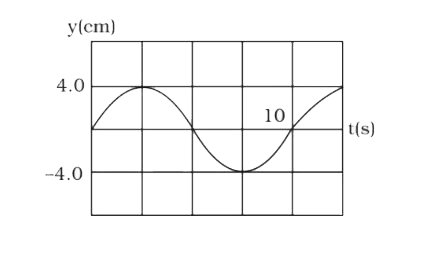
The figure shows the shape of three strings on which sinusoidal transverse waves are propagating. The arrows in the diagram indicate the direction of wave propagation. Out of the 6 particles marked (1, 2, 3, 4, 5, 6 ) how many have their instantaneous velocity and acceleration both directed towards their mean position.
The correct Answer is:Three
Step by step video, text & image solution for The figure shows the shape of three strings on which sinusoidal transverse waves are propagating. The arrows in the diagram indicate the direction of wave propagation. Out of the 6 particles marked (1, 2, 3, 4, 5, 6 ) how many have their instantaneous velocity and acceleration both directed towards their mean position. by Physics experts to help you in doubts & scoring excellent marks in Class 11 exams.
Topper's Solved these Questions
Similar Questions
A long taut string is plucked at its centre. The pulse travelling on it can be described as y(x,t)=e−(x+2t)2+e−(x−2t)2. Draw the shape of the string at time t=0, a short time after t=0 and a long time after t=0.
01:36View SolutionDuring a painting process, a thin, flat tape of width b (dimension perpendicular to the plane of the figure) is pulled through a paint filled channel of length L. The density and viscosity of the paint liquid is ρ and η respectively. The tape is pulled at a constant speed v and width of the channel is h. Find the minimum force needed to pull the tape.
 02:07View Solution
02:07View Solution(i) The cause of increases in kinetic energy when a man starts running without his feet slipping on ground is asked to two students. Their answers are– Harshit: Cause of increase in kinetic energy is work done by friction force. Without friction the man cannot run. Akanksha: Cause of increase in kinetic energy is work done by internal (muscle) forces of the body. Who is right? (ii) An inextensible rope is hanging from a tree. A monkey, having mass m, climbs to a height h grabbing the rope tightly. The monkey starts from rest and ends up hanging motionlessly on the rope at height h. (a) How much work is done by gravity on the monkey? (b) How much work is done by the rope on the monkey? (c) Using work – energy theorem, explain the increase in mechanical energy of the monkey.
02:12View SolutionIf the direction of the vibration of particles is parallel to the direction of the propagation of a wave , then the wave is
01:52View SolutionStatement-1: Waves on a string are always transverse in nature. ltBrgt Statement-2: The velocity of a transverse wave propagating along a string is independent of the frequency of the propagating wave.
01:51View SolutionA transverse sinusoidal wave of wavelength 20 cm is moving along a string towards increasing x. the transverse displacement of the string particle at x=0 as a function of time is shown in figure.

Q. The velocity of propagation of the wave is ?03:51View SolutionA transverse wave of amplitude 0.5m, wavelength 1m and frequency 2 Hz is propagating in a string in the negative x direction. The equation of this wave is
01:27View SolutionIn case of propagation of transverse waves, angle between directions of velocity of particle and velocity of wave is π rad.
01:59View SolutionHow is the direction of the oscillation of the particles of the medium related to the direction of propagation of the sound wave?
03:11View SolutionA transverse wave of amplitude 2 m, wavelength 4 m and frequency 6 Hz is propagating in a string toward positive y-direction. The equation of the wave may be (y is in m and t is in s)
02:14View SolutionIf the direction of the vibration of particles is parallel to the direction of the propagation of a wave , then the wave is
01:53View SolutionStatement-1: Waves on a string are always transverse in nature. Statement-2: The velocity of a transverse wave propagating along a string is independent of the frequency of the propagating wave.
02:32View SolutionA transverse wave of amplitude 2 m, wavelength 4 m and frequency 6 Hz is propagating in a string toward positive y-direction. The equation of the wave may be (y is in m and t is in s)
02:29View SolutionA transverse sinusoidal wave of wavelength 20 cm is moving along a string towards increasing x. the transverse displacement of the string particle at x=0 as a function of time is shown in figure.

Q. The velocity of propagation of the wave is ?View SolutionIn ........ waves particles of the medium oscillate in perpendicular direction of the Propagation (longitudinak,transverse ,sound)
View Solution

